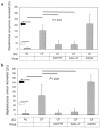Transfer of a cathelicidin peptide antibiotic gene restores bacterial killing in a cystic fibrosis xenograft model
- PMID: 10207162
- PMCID: PMC408283
- DOI: 10.1172/JCI6570
Transfer of a cathelicidin peptide antibiotic gene restores bacterial killing in a cystic fibrosis xenograft model
Abstract
Recent studies suggest that the gene defect in cystic fibrosis (CF) leads to a breach in innate immunity. We describe a novel genetic strategy for reversing the CF-specific defect of antimicrobial activity by transferring a gene encoding a secreted cathelicidin peptide antibiotic into the airway epithelium grown in a human bronchial xenograft model. The airway surface fluid (ASF) from CF xenografts failed to kill Pseudomonas aeruginosa or Staphylococcus aureus. Partial reconstitution of CF transmembrane conductance regulator expression after adenovirus-mediated gene transfer restored the antimicrobial activity of ASF from CF xenografts to normal levels. Exposure of CF xenografts to an adenovirus expressing the human cathelicidin LL-37/hCAP-18 increased levels of this peptide in the ASF three- to fourfold above the normal concentrations, which were equivalent in ASF from CF and normal xenografts before gene transfer. The increase of LL-37 was sufficient to restore bacterial killing to normal levels. The data presented describe an alternative genetic approach to the treatment of CF based on enhanced expression of an endogenous antimicrobial peptide and provide strong evidence that expression of antimicrobial peptides indeed protects against bacterial infection.
Figures


References
-
- Davis PB, Drumm M, Konstan MW. Cystic fibrosis. Am J Respir Crit Care Med. 1996;154:1229–1256. - PubMed
-
- Engelhardt J, et al. Submucosal glands are the predominant site of CFTR expression in the human bronchus. Nat Genet. 1992;2:240–248. - PubMed
-
- Welsh MJ, Ramsey BW. Research on cystic fibrosis. Am J Repir Crit Care Med. 1998;157:S148–S154. - PubMed
-
- Smith J, Travis S, Greenberg E, Welsh M. Cystic fibrosis airway epithelia fail to kill bacteria because of abnormal airway surface fluid. Cell. 1996;85:229–236. - PubMed
Publication types
MeSH terms
Substances
Grants and funding
LinkOut - more resources
Full Text Sources
Other Literature Sources
Medical

